Jean had read in the travel books that in Brazil, it was okay for women to wear shorts at night, but men usually put on a pair of long pants. LONG PANTS! I HATE LONG PANTS! Especially in 90 degree weather with 150% humidity. I relented, however, fearing that I’d be mocked by the whole country if I showed up somewhere in shorts at night. I went to the mall and bought a pair of black pants that had a drawstring waist (it’s all I could find). I wasn’t about to tuck anything in, especially in Brazil, so I figured they would do fine.
We had wanted to see Salvador not just in Carnaval costume, but as a day-to-day place to live. Unfortunately, a lot of things had closed not only for Carnaval, but for the peripheral days as well. But Carol had such an extensive knowledge of her city that any type of excursion would yield something interesting.
Carol mentioned that our afternoon outing might stretch into evening and dinner, and I asked if I had to wear long pants. She suggested that I do, in case we went anywhere for dinner that was less than casual. I went for the new black pants and put them on. They were so blousy and leggy that they looked more like hostess pants. Hostess pants for a really fat hostess. Yeah, the Brazilians weren’t gonna laugh at those!
Whatever.
I threw on my favorite blue shirt, later discovering that there was a big hole in the back. Change that to “fat hobo hostess”.
We cruised around Salvador for a while, marveling at the way Carol drove her SUV (expensive, gas guzzling SUV–she knows.) through maniacal traffic like it was second nature. I sensed a rhythm to the whole thing, sort of like an elaborate ballet. People would shift and merge fairly smoothly, and though they were usually hauling ass while they did it, it was accomplished with little stress. Or so it appeared. There was very little honking of horns, and I didn’t see any kind of irritated gestures from any of the participants. The whole Bahian thing obviously permeates all of life in Salvador.
We briefly went through part of the historic district, which is a wall of incredible colonial architecture at the base of a giant rock face. The Lacerda Elevator was right around there, and I stupidly didn’t photograph it. We were in a moving SUV, so I guess that’s an excuse. When we passed the Bahian Woman, by Mario Cravo Junior, I had to snap one through the front windshield. Note the blue tint at the top. This sculpture was gorgeous, and conveyed its name clearly and beautifully.
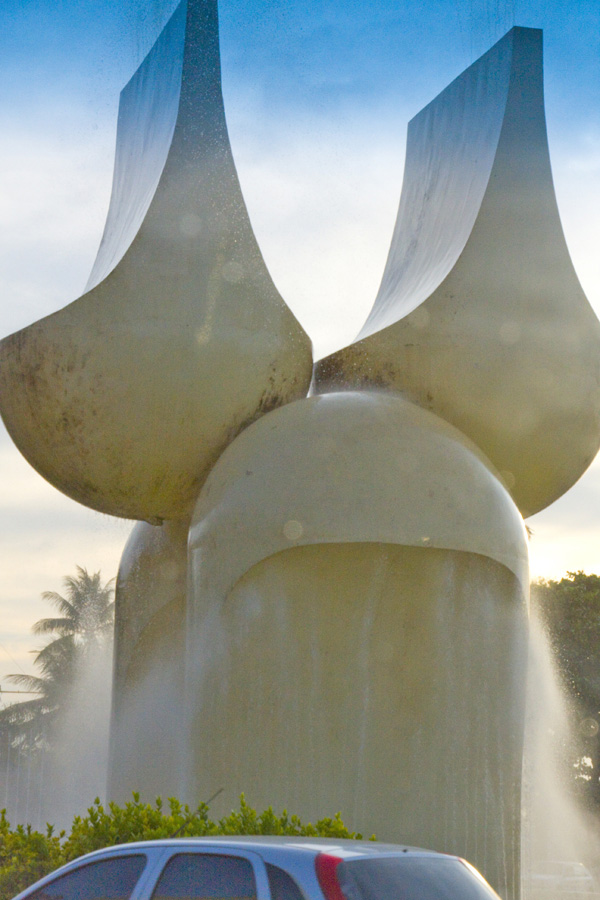 I gawked at the architecture, and marveled at the way the Brazilians embraced their structures, regardless of the style. They seem to be more free to experiment with modern and retro-modern designs that were functional as well as beautiful. My father, also an architect, had the same opinion of the Brazilian sensibility after a trip to São Paulo in the late 60s. He was not only smitten with the culture and music, but the architecture and great acceptance of the cool designs by the people was totally endearing to him.
I gawked at the architecture, and marveled at the way the Brazilians embraced their structures, regardless of the style. They seem to be more free to experiment with modern and retro-modern designs that were functional as well as beautiful. My father, also an architect, had the same opinion of the Brazilian sensibility after a trip to São Paulo in the late 60s. He was not only smitten with the culture and music, but the architecture and great acceptance of the cool designs by the people was totally endearing to him.
One of the particular standouts I noticed in Salvador was a native Salvadoran, Fernando Peixoto, whose geometrically designed buildings dotted the landscape frequently. Many of the places that got an initial “gaaahhhh-laaaay” from me were by Peixoto. Two of his most telling influences are Victor Vasarely and Op-art. Carol also explained that he found beauty in the favelas, Brazilian shanty towns. They are quite beautiful as they appear sporadically around the city, looking like intricate block sculptures planted on the side of a hill. Peixoto has echoed the linear essence of the favelas in some of his work, and it gives the interesting melange of buildings in Salvador a nice relationship.
Our first official stop on the outing was the Museum of Modern Art of Bahia. This sprawling beauty is part of Solar do Unhão, a colonial mansion dating to the late 1600s.
To begin with, the descent to the parking lot alone was an adventure. A super-tight right turn down a steep cobblestone drive (with no railing, as I seem to recall) and then another tight right turn just before we plunged into the sea and we were there!
Of course, we found out that the inside was closed, but there was plenty to take in outside, starting with the view from the parking lot.
.
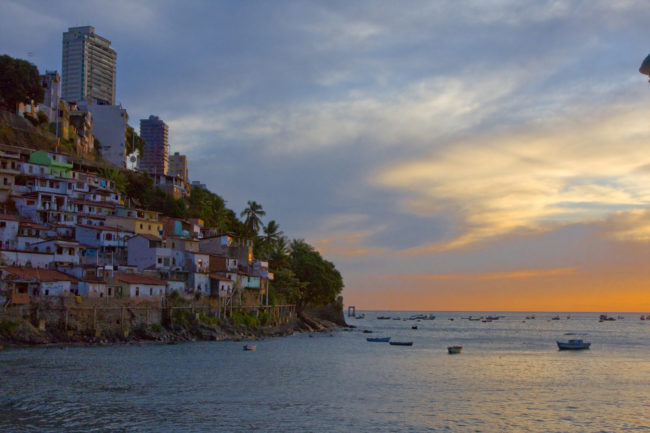 If there’s such a thing as a “picture postcard” view, this is it.
If there’s such a thing as a “picture postcard” view, this is it.
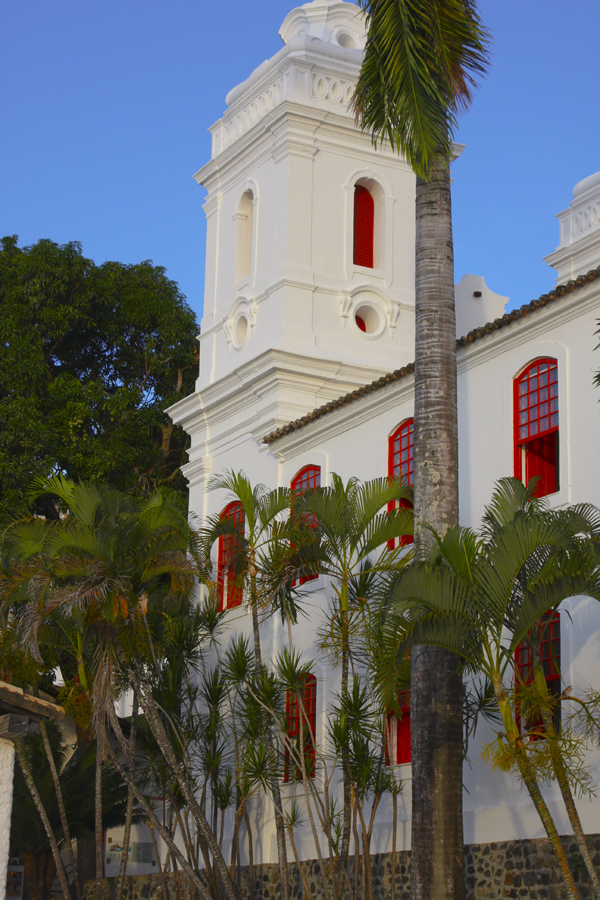 We headed in only to find out that the inside was closed. It didn’t deter us from gawking at the buildings that spilled down the hill, halting short of the water.
We headed in only to find out that the inside was closed. It didn’t deter us from gawking at the buildings that spilled down the hill, halting short of the water.
 This place was breathtaking, to say the least. Even though we couldn’t get inside, the art outside was stimulating.
This place was breathtaking, to say the least. Even though we couldn’t get inside, the art outside was stimulating.
The sunset was beautiful, as the pictures attest. The lambent light at the end of the day is intoxicating anywhere in the world, but in Brazil, it seemed to be even more dazzling than other places. The unbroken sea views punctuated by a great variety of houses and buildings, many painted white, hanging from the hill, caught the light and sent it back with more intensity. It was very strange.
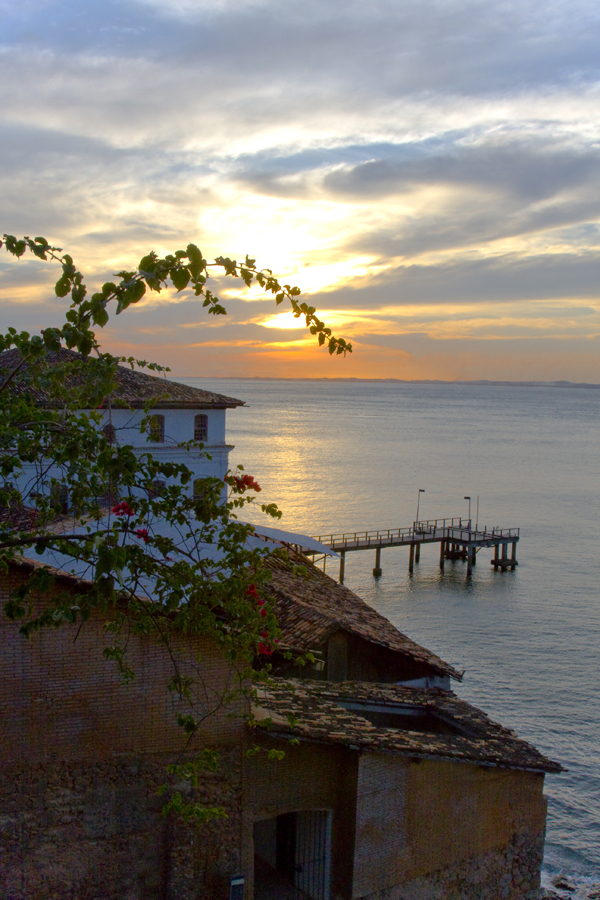
Looking over the rails on one of the several paths that meandered down the steep hill, we saw three plaster figures lying in a row on the ground. They were creepy-cool, kind of like a Pompeii exhibit or something. It was hard to tell if they were representing sleeping people, dead people, or volcano-fried people.
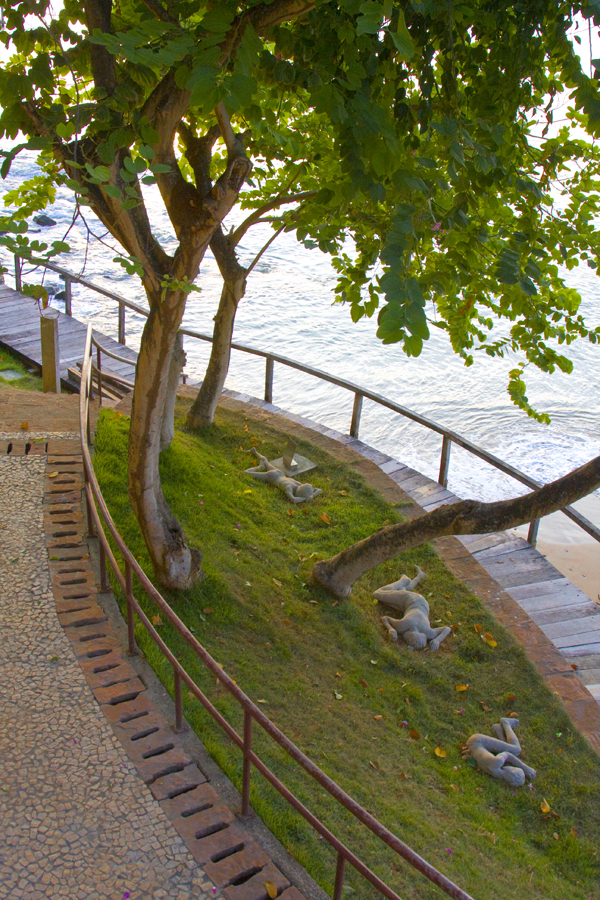 The iron gates, by Argentinian born, naturalized Brazilian artist Carybé, were especially striking against the sky and sea.
The iron gates, by Argentinian born, naturalized Brazilian artist Carybé, were especially striking against the sky and sea.
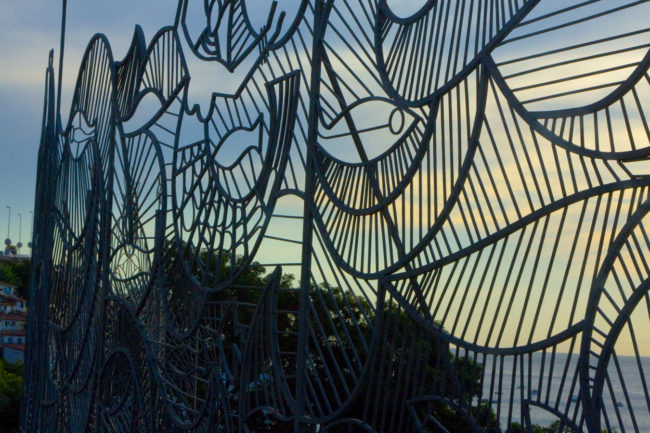
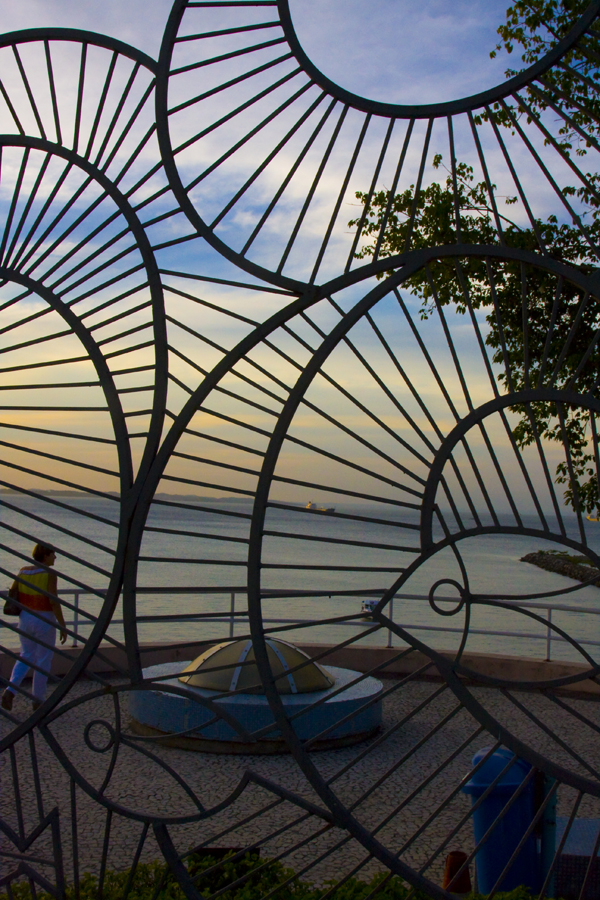
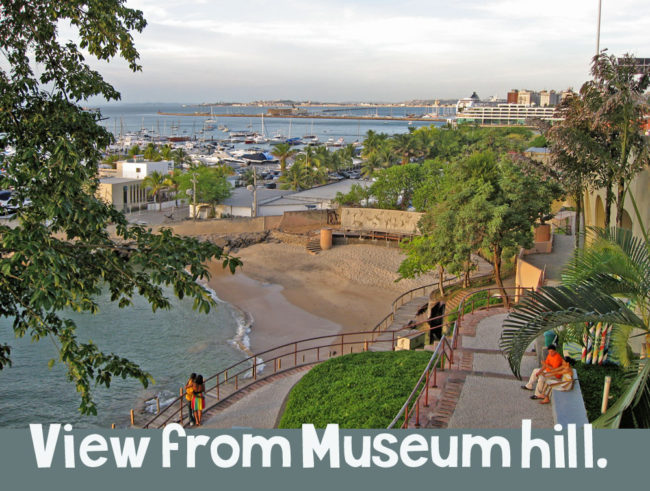 By this time, after hiking up and down the various paths, I was sweating healthily, and the blousiness of the pants was doing nothing to belie the fact that I was quickly becoming galded. If you’re not familiar with the term, “galded” is what happens to you when you take a long walk on the beach with a wet, sandy bathing suit on. Being galded makes you walk bowlegged. It also makes you wish you had an industrial drum of baby powder handy. My college roommate, David Franklin, introduced me to the term, and it best describes the condition.
By this time, after hiking up and down the various paths, I was sweating healthily, and the blousiness of the pants was doing nothing to belie the fact that I was quickly becoming galded. If you’re not familiar with the term, “galded” is what happens to you when you take a long walk on the beach with a wet, sandy bathing suit on. Being galded makes you walk bowlegged. It also makes you wish you had an industrial drum of baby powder handy. My college roommate, David Franklin, introduced me to the term, and it best describes the condition.
No matter. I was tough. I refused to crack. The pants hadn’t gotten me, and I refused to let a little chafing get in the way. I was still too pumped to be there and see all the incredible new stuff.
After thoroughly exploring everything outside, we headed back to the parking lot for a rapidly changing sunset.
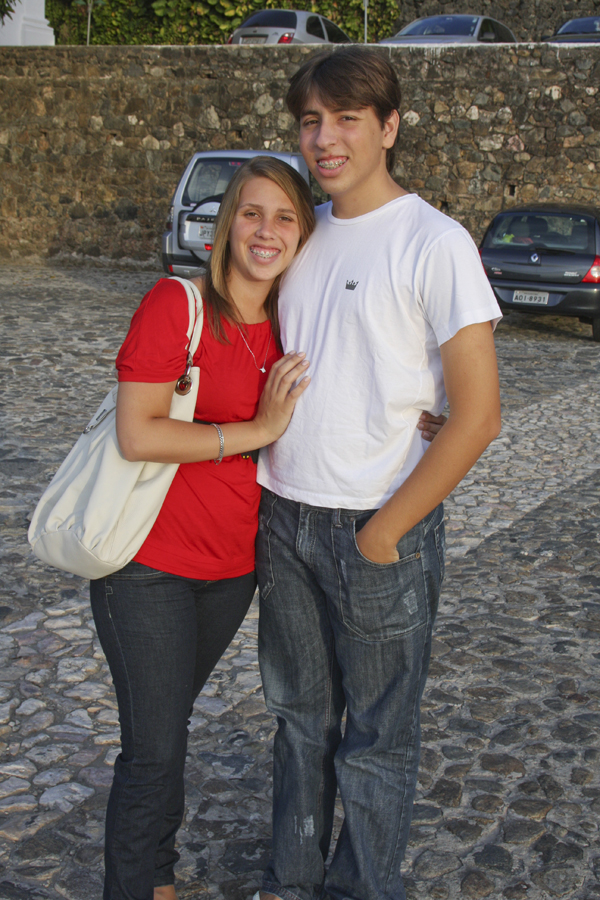 Here’s a great shot of Daniel and Patricia in the parking lot. Daniel originally had a great looking prom-night- quality zit, but I Photoshopped it out. Notice Carol’s SUV in the background.
Here’s a great shot of Daniel and Patricia in the parking lot. Daniel originally had a great looking prom-night- quality zit, but I Photoshopped it out. Notice Carol’s SUV in the background.
We hung around the parking lot for a good while looking at the sunset reflect on the water, and generally bathed in the glow.
There were several Carnaval-goers sitting under this antique boat hoist smoking a big fatty. It just seemed another portent of Carnaval. Nobody seemed to care much. We all commented on it, but Carol didn’t freak out, the kids barely acknowledged it, and it was truly a Bahian moment.
I was taking pictures of the hoist and sunset, and I’m sure the partiers were initially paranoid about my camera. But then they saw the hole in my shirt, the blousy pants, the Crocs and the bowlegged walk, and figured I was too ridiculous to be threatening.
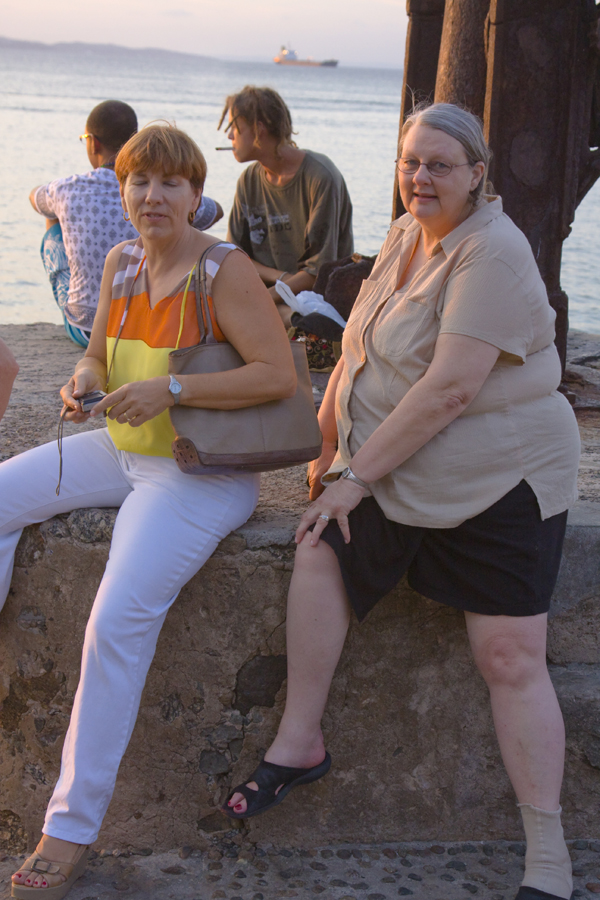 Spliff by the sea in Bahia.
Spliff by the sea in Bahia.
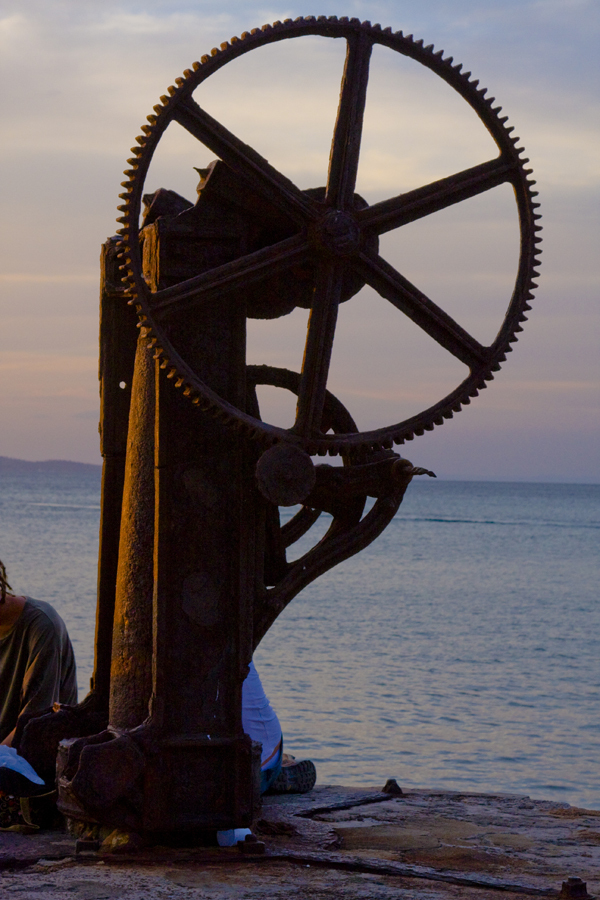 I’m sure that in the picture below Carol is explaining something about how the boats used to land there and have to get up the rocky cliff or some other historical nugget. She was a geography major at Indiana U, with a masters in urban planning, but her love of history is one thing that stands out. She is a font of knowledge that made every visit a learning experience. And learning is FUN!
I’m sure that in the picture below Carol is explaining something about how the boats used to land there and have to get up the rocky cliff or some other historical nugget. She was a geography major at Indiana U, with a masters in urban planning, but her love of history is one thing that stands out. She is a font of knowledge that made every visit a learning experience. And learning is FUN!
Look at Robo in the photo. What do you think he’s saying? I love pictures like this, where the narrative is unclear, and subject to interpretation.
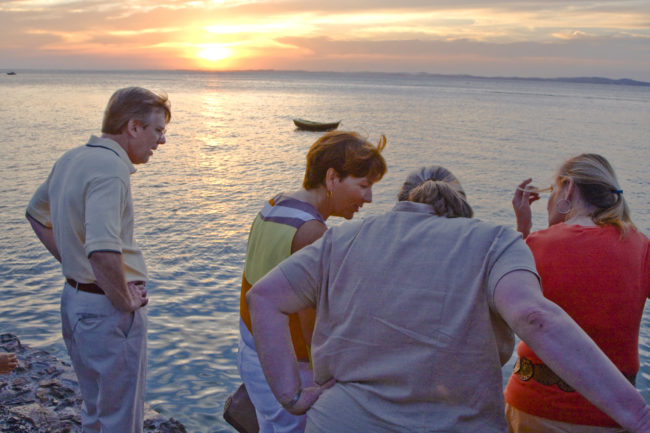
I suppose part of Jean’s fear of photography comes from the lengthy period in our marriage where I would always try to take pictures of her butt when we were at the beach. I don’t know why, it’s just that beach butts are funny.
She finally got me back with a photo of me that was so heinous that I never again wallowed in butt shots. Our relationship is so much stronger now. I don’t take pictures of her butt anymore, I now tell random waiters and salespeople how she has ruined my life.
Carol had decided next to cruise the parade route, and see what might pop up. On the way, we stopped at a beautiful mannerist style church from the 1600s, Santo Antonio Church. It sat majestically at the top of the hill, and was accessed by a steep set of stairs.
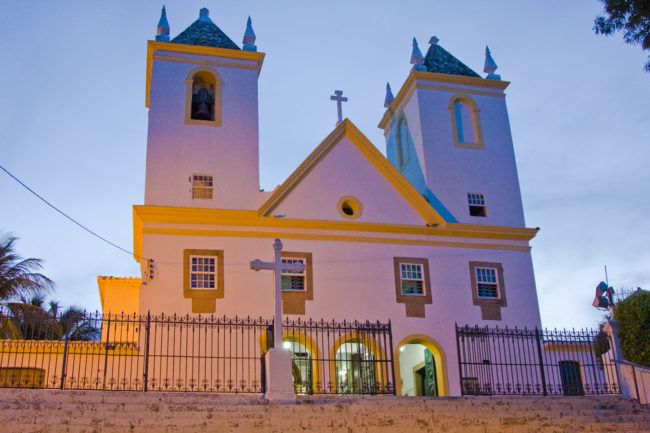 To the left was a grotto with Statuary of Maria, the Vatican (I would assume? please correct me).
To the left was a grotto with Statuary of Maria, the Vatican (I would assume? please correct me).
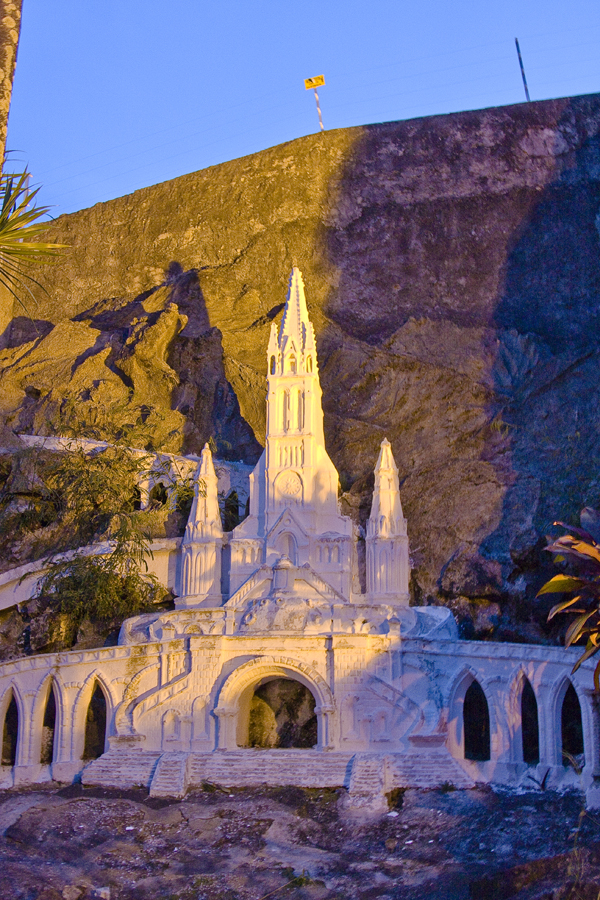 After I had made it up the stairs, I discovered that there was a service going on. It’s always weird to me to see modern usage of old churches. I ripped off a couple of surreptitious photos, but in one, the priest seems to be glaring at me. I guess that may explain the fact that right after, I fell down the stairs.
After I had made it up the stairs, I discovered that there was a service going on. It’s always weird to me to see modern usage of old churches. I ripped off a couple of surreptitious photos, but in one, the priest seems to be glaring at me. I guess that may explain the fact that right after, I fell down the stairs.
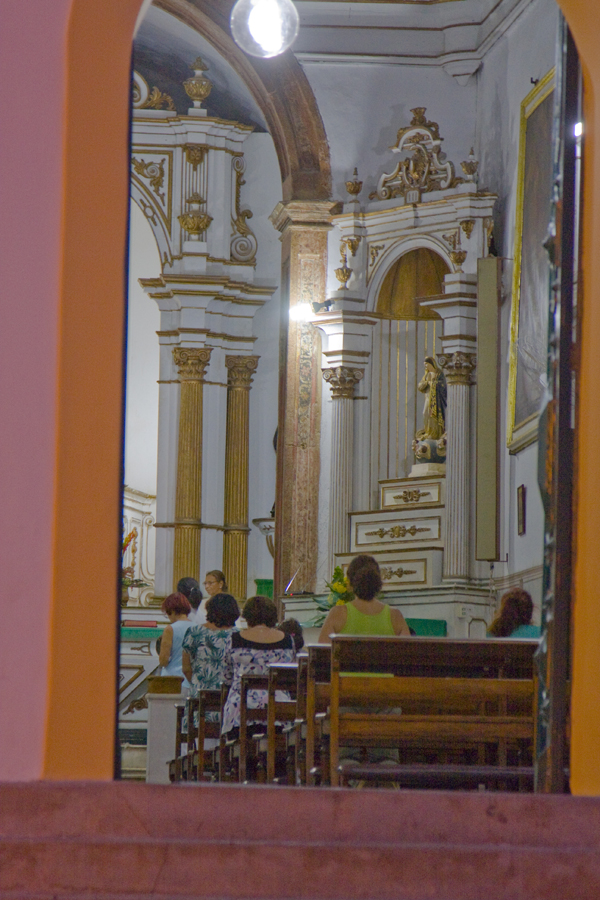
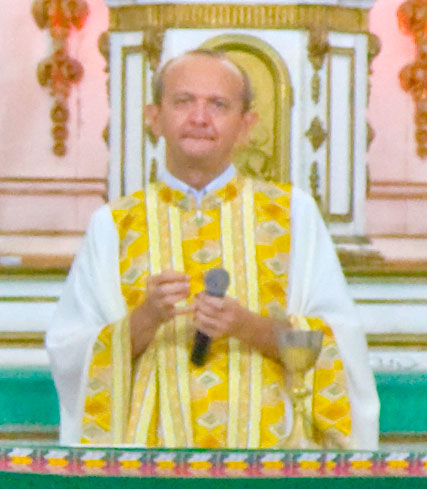
All right. I didn’t actually fall down the stairs. But the look on his face as he grips his Mr. Microphone is strictly business.
We got back in the car, passing by a guy sleeping on the ground under a tree. Was he homeless? Drunk? We didn’t bother him. There was another guy there who was hell bent on making sure we were able to park and get out of there without any problem. I think it was another take on the old “wash the windshield” gag that’s so popular in big cities. It has a definite upside as well, I suppose. For a few Reais, you can have one of the locals look after you. They will make sure nothing happens to you or your car while they’re around. This local pick-up help was everywhere, and they all seemed to operate the same way. Carol tipped several locals while we were there for performing various impromptu semi-security tasks. Once again, a natural part of the Bahian rhythm.
We proceeded on, along one of the parade routes. During the ride, I snapped a couple of shots from the moving car that are extraordinarily cool
.
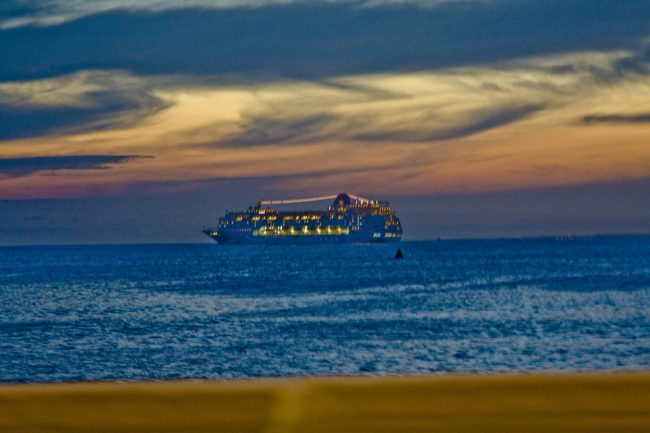
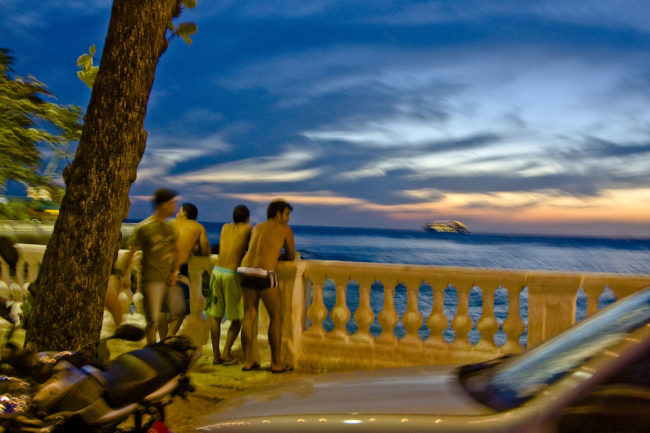
The close proximity of the sea to the road was neat. The whole place was beginning to pack with vendors of all kinds, people selling drinks out of coolers, everything. I noticed that throughout Brazil, individual entrepreneurs would sell drinks out of their own home coolers.
